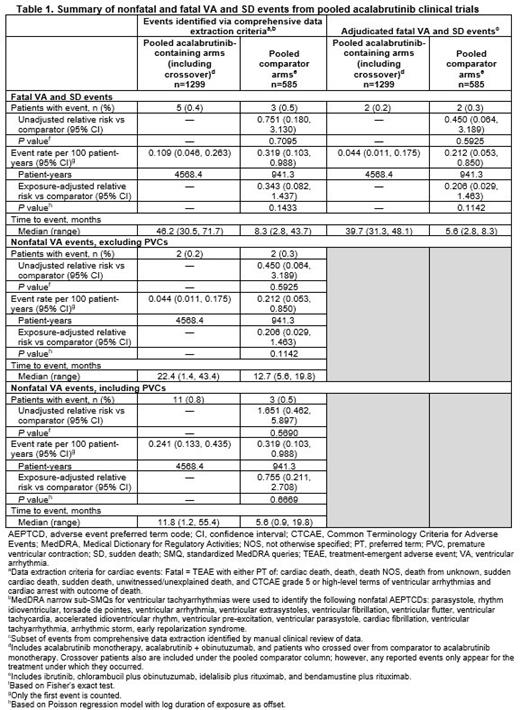Background: The approval of ibrutinib, the first covalent Bruton tyrosine kinase inhibitor (BTKi), provided an effective non-chemotherapy option for the treatment of B-cell malignancies, such as chronic lymphocytic leukemia (CLL)/small lymphocytic lymphoma (SLL). While generally well tolerated, ibrutinib demonstrated significant toxicities in clinical studies, particularly cardiovascular adverse events such as hypertension, atrial fibrillation, and ventricular arrhythmias (VAs). Post hoc analysis of the phase 3 FLAIR trial in patients with previously untreated CLL reported an unexplained sudden or cardiac death rate of 0.5 patients per 100 patient-years with ibrutinib plus rituximab (Hillmen et al. Lancet Oncol. 2023). Acalabrutinib is a next-generation, more selective, irreversible BTKi approved to treat CLL/SLL and relapsed/refractory mantle cell lymphoma. Herein, the rates of nonfatal and fatal VAs and sudden deaths (SDs) from 5 acalabrutinib clinical trials of patients with CLL were analyzed.
Methods: Incidence and relative risk of nonfatal and fatal VAs and SDs were analyzed using pooled data from 5 prospective acalabrutinib clinical trials (nonrandomized trials: CL-001 [acalabrutinib monotherapy], CL-003 [acalabrutinib + obinutuzumab]; randomized trials: CL-006 [acalabrutinib vs ibrutinib], CL-007 [acalabrutinib ± obinutuzumab vs chlorambucil + obinutuzumab], CL-309 [acalabrutinib vs idelalisib + rituximab OR bendamustine + rituximab]). Acalabrutinib-containing arms were pooled as a single group; comparators, which were standard-of-care therapies, were pooled as a separate group. Events were identified by comprehensive data extraction of terms capturing nonfatal and fatal VAs and SDs (terms are defined in Table 1 footnote). Nonfatal events were analyzed with and without the inclusion of premature ventricular contractions (PVCs). A subset of fatal events also was analyzed after adjudication through manual clinical review by the sponsor's medical, clinical, and safety leadership.
Results: In total, 1299 patients received acalabrutinib (cumulative exposure, 4568.4 patient-years) and 585 received standard-of-care therapies (comparator group) (941.3 patient-years). Considering only fatal VAs and SDs, 5 (0.4%) and 3 (0.5%) patients had an event in the acalabrutinib and comparator groups, respectively, via comprehensive data extraction ( Table 1). Based on exposure-adjusted event rates per 100 patient-years, fatal VAs and SDs were numerically less frequent for acalabrutinib versus comparators; however, relative risks did not statistically favor either group. This trend persisted when events were adjudicated through manual clinical review. After adjudication, 2 of 5 patients in the acalabrutinib group and 2 of 3 patients in the comparator group were determined to have fatal VA or cardiac-related SD. Nonfatal VAs were reported in 11 (0.8%) patients in the acalabrutinib group and 3 (0.5%) patients in the comparator group. When PVCs were excluded, 2 patients in each group (acalabrutinib, 0.2%; comparator, 0.3%) had nonfatal VAs. These nonfatal VAs consisted of ventricular fibrillation (acalabrutinib, n=2 [grades 2 and 4]; comparator, n=1 [grade 4]) and unspecified VA (comparator, n=1 [grade 1]). Although the acalabrutinib group had a lower exposure-adjusted event rate per 100 patient-years than the comparator group, relative risk did not favor either group. With both fatal and nonfatal VAs (with or without PVCs), time to event was notably longer with acalabrutinib than with comparators ( Table 1). A sensitivity analysis excluding the ibrutinib-treated patients from the comparator cohort yielded overall similar results (data not shown).
Conclusions: This pooled analysis of prospective acalabrutinib clinical trials demonstrates that the risk of VA and SD with acalabrutinib is low and similar to that of standard-of-care therapies when adjusted for exposure. The current analysis with more than 1200 patients treated with acalabrutinib points to favorable safety outcomes and no specific trend with SDs and VAs. Additional analyses with larger cohorts from the clinical development program and all postmarketing sources will continue to further characterize the safety profile of acalabrutinib.
Disclosures
Sharman:AbbVie, AstraZeneca, BMS, Beigene, Lilly, Genentech, Inc., Genmab: Consultancy; Merck, Novartis: Consultancy; Seattle Genetics: Research Funding; AbbVie, AstraZeneca, BeiGene, BMS, Genentech, Inc., Lilly: Consultancy. Ghia:AstraZeneca: Consultancy, Honoraria, Research Funding; MSD: Consultancy, Honoraria, Research Funding; Roche: Consultancy, Honoraria, Research Funding; Janssen: Consultancy, Honoraria, Research Funding; BeiGene: Consultancy, Honoraria, Research Funding; Lilly/Loxo Oncology: Consultancy, Honoraria, Research Funding; AbbVie: Consultancy, Honoraria, Research Funding; BMS: Consultancy, Honoraria, Research Funding. Palhares De Miranda:AstraZeneca: Current Employment, Current equity holder in private company, Current holder of stock options in a privately-held company. Bajwa:AstraZeneca: Current Employment. Rule:AstraZeneca: Current Employment. Shaw:AstraZeneca: Current Employment. Seymour:Gilead: Honoraria, Membership on an entity's Board of Directors or advisory committees; AbbVie: Honoraria, Membership on an entity's Board of Directors or advisory committees, Research Funding, Speakers Bureau; BMS: Consultancy, Honoraria, Membership on an entity's Board of Directors or advisory committees; Hoffmann-La Roche: Consultancy, Honoraria, Membership on an entity's Board of Directors or advisory committees, Speakers Bureau; Genor Bio: Membership on an entity's Board of Directors or advisory committees; AstraZeneca: Honoraria, Membership on an entity's Board of Directors or advisory committees; Janssen: Honoraria, Membership on an entity's Board of Directors or advisory committees; Beigene: Honoraria, Membership on an entity's Board of Directors or advisory committees, Speakers Bureau; TG Therapeutics: Consultancy; F. Hoffmann-La Roche Ltd: Research Funding.


This feature is available to Subscribers Only
Sign In or Create an Account Close Modal